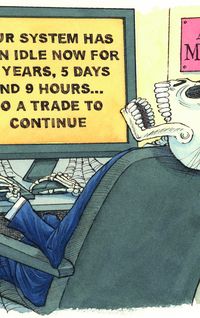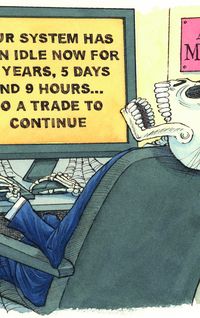A long-term commitment to re-balancing the Chinese economy should make the M&A boom more sustainable. But worries about capital flight and the renminbi’s weakness may force the authorities to put a stop to the party.
Global mergers and acquisitions activity fell in 2016 from the previous year’s record, but there was one pocket of extraordinary growth – the record volume of cross-border acquisitions by Chinese companies across Europe and the US.
Chinese companies have been busy buying Western assets over the last three years, diversifying overseas to combat a slowdown in their domestic economy. But this trend accelerated dramatically in February 2016 when China National Chemical Corp, or ChemChina, launched a US$46.6bn bid for Swiss pesticides group Syngenta, the biggest outbound acquisition on record.
This deal helped propel foreign acquisitions by Chinese companies to a record US$195bn for the year to November 7, eclipsing the US$107bn of deals signed in the whole of 2015, according to Thomson Reuters’ numbers.
Chinese companies are now a significant force in global deal-making and Chinese M&A accounted for 20% of announced global deal activity in 2016, its highest on record and double the proportion three years ago.
The bulk of the action is taking place in Europe, where Chinese companies announced deals with a combined value of US$75bn, compared with US$26bn last year. In North America, the value of China-backed M&A sky-rocketed to US$57bn from just US$8bn in 2015.
Chinese buyers, whether state-owned enterprises or privately-owned companies, have the financing and advisory expertise in place to execute multiple deals in quick succession and many sellers look east as a matter of course when trying unload assets.
For example, Blackstone Group has sold three businesses to Chinese buyers in the space of two months, including the sale in October of a 25% stake in hotel group Hilton Worldwide Holdings to Chen Feng’s HNA Group for US$6.5bn.
“Chinese companies have gone from left-field buyers of assets to prolific serial acquirers in a relatively short space of time,” said Rob Pulford, head of financial sponsors coverage for Europe, the Middle East and Africa at Goldman Sachs in London.
Cutting red tape
The impetus for this M&A boom began three years ago when China launched its Made in China 2025 initiative, which aims to pivot China away from being a low-cost manufacturing hub and reduce its reliance on foreign imports of technology.
Then, the government’s 13th and most recent five-year plan strengthened this resolve by highlighting 10 sectors where China wants to develop world-class expertise – from robotics, to financial services and telecoms. At the same time, the government has created a more conducive climate by softening regulations on outbound M&A to cut red tape and ease execution.
This commitment has unleashed a wave of activity but also helped to shift the perception away from Chinese buyers as unreliable bidders who are unable to deliver after showing an initial interest in auctions. Now, bankers tasked with selling assets for Western corporates or private equity firms visit China regularly and consistently find motivated buyers ready to do deals.
“Chinese buyers tend to have local bank funding in place and while they are keen to use banks for advice on deals, we rarely receive requests for financing,” said Pulford.
This flow of easy money is reminiscent of the M&A acquisition spree led by Middle Eastern sovereign wealth funds in the run-up to the financial crisis, but bankers believe the sheer amount of firepower at the disposal of Chinese companies and the long-term commitment to re-balancing the Chinese economy make this M&A boom more sustainable.
“There is a ‘China premium’ and they can pay to win because they are taking a long-term view,” said Pulford.
In the past, Chinese buyers either avoided using banks for advice or balked at paying fees but now they are keen to have Western banks on their side as a sign of their commitment. So much so that in one recent auction a Chinese bidder said it would pay a Western bank a fee purely so it could name it as its adviser, one M&A banker said.
Chinese companies have also become increasingly savvy M&A players.
James Simpson, co-head of EMEA M&A at HSBC in London, said: “Chinese buyers are becoming increasingly sophisticated and we’re seeing evidence of that. Opportunities are being tracked, and relationships built over multi-year periods. Financing is using both local and international capital markets, and speed of execution now often compares with that of private equity.”
Highly strategic
ChemChina’s bid for Syngenta is a case in point. While the deal was made in China, it was executed with all the hallmarks of any big-ticket cross-border deal. Executives of ChemChina, which regards Syngenta as a highly strategic asset as China looks to develop its agricultural sector, began their approach to the Swiss company during the summer of 2015. But once the two companies agreed the basis of a deal, it took only three weeks to complete due diligence, put certain financing in place to meet the regulatory requirements of the SIX Swiss Exchange and move to announcement.
HSBC underwrote a US$20bn non-recourse loan, while Citic underwrote up to US$30bn of recourse loans. The non-recourse piece and US$12.7bn of the recourse piece were then syndicated to a broader banking group.
But it is not just a story of state-owned enterprises seeking diversification. This M&A trend is also being fuelled by a new generation of private companies that are looking to buy Western assets, either to build global scale or to roll out brands and technology in their home markets.
“The outbound M&A wave by Chinese companies is transforming the M&A landscape,” Simpson said. ”Where activity used to be targeted towards the resources sector, we are now seeing activity across a broader group of industry sectors.”
In June, for example, Dutch technology group NXP sold its standard products business for US$2.75bn to a consortium of financial investors led by Beijing Jianguang Asset Management.
Investment companies such as Fosun and HNA have also been on buying sprees, supported by an eco-system of advisers and lenders that are developing at a local level in countries such as Germany, where Chinese buyers have concluded deals worth a record US$10bn so far this year. The biggest of these was Midea Group’s US$4.5bn acquisition of Kuka, a German robotics company.
Anxiety
There are, however, reasons to worry that the surge of M&A deals from China will now falter. A series of press reports at the end of November suggest that the Chinese authorities, concerned that capital flight is accentuating falls in the value of the renminbi, might seek to put a stop to – or at least slow down – outbound deals.
The reports said that deals of more than US$10bn would draw particular scrutiny, as would deals over US$1bn that were not related to the acquirer’s core business.
But bankers are hopeful that the proposals will still not bring an abrupt halt to the M&A bonanza.
“When this policy comes in it will basically emphasise that deals can’t be done merely as way for private individuals and companies to get money outside China,” said a senior M&A banker at a major global bank.
“I expect in the short term this will dampen down deal flow quite a lot, but I still think the major deals done for strategic reasons will come through and be able to be done.”
The surge of activity has also created anxiety among governments in some European countries. For example, German Chancellor Angela Merkel expressed concern about Midea’s bid for Kuka, the biggest acquisition of a German company by a Chinese acquirer, but the deal still went ahead.
In November, Germany’s economy ministry opened a review into the planned acquisition of Aixtron, which supplies equipment to the semiconductor industry, by China’s Grand Chip Investment. These actions suggest a backlash but bankers don’t believe they will derail the boom, although it might curb M&A in sectors where there is a perception that national security could be undermined.
“Political rhetoric has increased from Western countries about in-bound Chinese M&A, particularly with multiple elections due in 2017,” Simpson said.
“This shouldn’t dampen activity but it does require careful stakeholder management. Banks can make a difference by having a deep bench of connectivity to help firms articulate the rationale of deals to shareholders, employees and politicians.” ChemChina’s acquisition of Syngenta secured approval from the US regulator in August.
The deal wave has been funded by Chinese banks offering cheap debt. Bankers worry that might not be sustainable, particularly as Chinese buyers are become less discerning as they look to snap up assets across the globe.
Some Chinese companies are already looking to finance deals using banks and investment partners in local markets, in case funding conditions tighten at home.
“China wants to be more balanced in terms of foreign exchange and the outflows have been significant,” one China-based M&A banker said.
“We have seen deals using international banks on the debt side with ChemChina and Syngenta but I also think we’ll start to see it on the equity side, where private equity or sovereign wealth funds will start to partner with Chinese companies to fund deals.”
It is certainly true that regulatory actions or a sharp slowdown in the Chinese economy could derail the M&A boom but, looking longer term, bankers expect to ride the deal wave well into 2017 and beyond.
“The China M&A story has only just started. We have barely scratched the surface in terms of activity in some industries,” said Pulford.
To see the digital version of this review, please click here.
To purchase printed copies or a PDF of this review, please email gloria.balbastro@tr.com


























